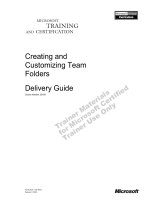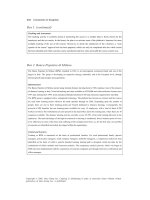Tài liệu Microsoft Enterprise Project Management 2010 Licensing Guide pptx
Bạn đang xem bản rút gọn của tài liệu. Xem và tải ngay bản đầy đủ của tài liệu tại đây (7.34 MB, 8 trang )
Microsoft Enterprise
Project Management 2010
Licensing Guide
Individual Project Management
Microsoft Project Standard and Project
Professional (used as standalone applications)
and SharePoint task lists can help full-time
and part-time project managers to create and
track schedules that enable project teams to
complete their work on time and within budget.
Workgroup Collaboration
and Reporting
By connecting Project Professional to
Microsoft Windows
®
SharePoint Foundation
(or Microsoft SharePoint Server), or by using
online project editing in Project Web App,
teams can more effectively collaborate and
successfully complete project work.
Unied Project and
Portfolio Management
In the latest version of the Microsoft EPM
solution, best-in-class portfolio management
techniques are included in Microsoft Project
Server 2010 to provide a single server that has
end-to-end EPM capabilities.
For Enterprise Project Management (EPM) solutions to be effective, they
need to provide organizations of different sizes and varying EPM maturity
levels with the appropriate tools to help ensure that teams can collaborate
to deliver projects successfully. A small or mid-size organization may have
different EPM requirements as compared to a multinational organization.
Organizations can achieve incremental gains in collaboration
capabilities by using products within the Microsoft Project and
Microsoft SharePoint
®
families. Large and small organizations alike can
deploy the EPM solution to successfully support project management.
Work Management Solutions for Individuals,
Teams, and the Enterprise
Microsoft Project 2010 Licensing
Microsoft
®
Project 2010 is a family of products that provide a range of functionality depending on organizational needs. Project 2010 allows
organizations to ease into the correct level of maturity for their work management needs.
The Project 2010 family consists of desktop and server products. Microsoft Project Standard 2010 and Microsoft Project Professional 2010 are
both desktop editions. The agship of the Enterprise Project Management solution is Microsoft Project Server 2010.
This guide will help you understand the relationship among the various Project editions, their interdependencies, and requirements. The goal of
this guide is to help identify the correct technologies to put in place in order to have an effective project management system.
Consistent server interface: Provide
the same experience whether people
are within SharePoint Server sites or in
Project Web App
Reporting: Quickly create a variety of
reports, dene key performance indicators
(KPIs), and congure powerful dashboards
Governance workow: Use workows to
better track the completion of key deliverables
Enterprise search: Use improved search
to nd people, documents, project
artifacts, and other project information
Social computing: Enable more
effective EPM team collaboration and
communication with wikis, blogs, and
people and expertise search capabilities
Portals: Create portals to enhance reporting
or centralize demand management
Line-of-business integration:
Streamline the use of multiple business
applications, systems, and servers for
seamless operation and provide a unied
view of work management information
EPM Solution Architecture
Project Server capabilities inherited from SharePoint
Report Center
Excel Services
Advanced charting and KPIs
Workow components
Benets to using Project Server in addition to Project Professional
Scorecards for in-depth business insight
Greatly expanded reporting options
Enhanced project and document workow
Gain leverage from full SharePoint collaboration capabilities
Project Server 2010 is built on top of SharePoint Server 2010. This
architecture enables customers and partners to take advantage of the
SharePoint Platform Services coupled with the project management
capabilities of the EPM solution to build powerful business solutions such
as EPM, innovation process management, investment governance, and
others. These solutions have the following features and capabilities:
Platform Architecture
In SharePoint Server 2010, use
application features such as Excel
Services, Report Center, workow, task
lists, and team sites.
Design, build, and modify existing
workows through Microsoft Visual
Studio
®
. Model additional workows from
those delivered with Project Server 2010.
Use project and portfolio performance
data from Project Server 2010 as a
source for performance reporting and
dashboard content.
In Microsoft Visual Studio Team
Foundation Server, synchronize project
tasks with Project Server 2010 tasks.
Enable integration with line-of-business
systems with the Project Server interface
and system management platforms such
as Microsoft System Center.
Project Server 2010 integrates Project and Portfolio Management
features and depends on Microsoft Windows Server
®
2008 (or 2008
R2) x64 editions, Microsoft SQL Server
®
2005 (or 2008) x64 editions,
and Microsoft SharePoint Server 2010. There are many opportunities
to take advantage of the Microsoft platform architecture for Project
Server 2010.
Roles in an EPM Implementation
Roles Responsibilities Suggested Client Interfaces
Team Member
Perform day-to-day activities such as work on tasks, timesheet submissions, status
communication, and participation in project collaboration processes. Team Member
is the default role for everyone in the resource pool.
Project Web App
Project Manager
Create and maintain project plans, schedule tasks, manage resources, track and
analyze progress, and communicate project status.
Project Standard 2010
or Project Professional 2010
with Project Web App
Resource Manager
View resource capacity and utilization information, and allocate resources
based on different criteria.
Project Professional 2010
with Project Web App
Executive
View the collective status of projects and portfolios with dashboards, drill-through
reports, and KPIs.
Project Web App
Project Management
Ofce (PMO)
Manage workows, templates, permissions, and other settings (with access to all
Project Manager, Resource Manager, and Executive capabilities).
Project Professional 2010
with Project Web App
Portfolio Analyst Help build, select, and manage projects that align with business objectives. Project Web App
Administrator Deploy, congure, and maintain the EPM solution (with access to all EPM capabilities).
Project Web App and
Project Professional 2010
The following table presents several roles in typical project management scenarios. The suggested client interfaces are the preferred interfaces
to accomplish tasks for that role, though users are free to use any number of client interfaces (including alternate interfaces such as Microsoft
Excel) to access Project data.
Capabilities by Product Types
The following table shows the main capabilities enabled by different
product types.
Capabilities
Products
Required
Simple navigation: Make every action easier
with graphical menus and an intuitive experience
Project Standard 2010
Project Professional 2010
Project Professional 2010 with SharePoint Foundation 2010
Project Server 2010 with SharePoint Server 2010
Timeline: Create timelines more easily with a
clear view of tasks, milestones, and phases
Flexible scheduling: Reduce the complexity of
viewing and updating schedules with the ability
to choose the level of detail
Resource management: Create the right mix of
resources visually by using drag-and-drop editing
Business intelligence: Make project
information available to more people by
creating reports and powerful dashboards
Synchronize project information with
SharePoint and Project Server 2010:
Enhance team collaboration by sharing
project information more efciently; enable
round-trip synchronization
Document management: Control document
review and approval through workow
Project and resource collaboration:
Create stronger team connections by using
Microsoft Project Server 2010 for Enterprise
Project Management
Enterprise search: Find people and locate
relevant project data more easily
Web-based project editing and calculations:
Build schedules online and conveniently update
basic project data from virtually anywhere
Time and task progress: Save time and unify
task status updates and timesheet submissions
by enabling single-entry mode
Unied project and portfolio management
(PPM): Provide a single server with end-to-
end PPM capabilities
Portfolio selection: Select project portfolios
that align with business strategy
Solution Environment
Servers and Clients in the EPM Solution
The EPM solution has two client front ends: Project Web Access and
Project Professional. All roles can use Project Web Access. Project
Managers also use Project Professional for detailed project planning
and tracking, and to publish updates to Project Server. For licensing
purposes, everyone who uses either front end needs a Project Server
Client Access License (CAL). Project Professional includes a Project
Server CAL.
Dependencies
The EPM solution provides work management capabilities on top of
the Microsoft core infrastructure, which many organizations already
have in place. The core infrastructure consists of Windows Server 2008
(or 2008 R2) x64 editions, SQL Server 2005 (or 2008) x64 editions, and
Microsoft SharePoint Server 2010.
Enhanced Tools
Microsoft Project Server 2010 is built on top of Microsoft SharePoint
Server 2010, which in combination enable powerful business
collaboration platform services and structured execution capabilities
to provide exible work management solutions such as the following:
Enterprise search
My Sites and social computing
Portals
Business intelligence and reporting
Customizable business processes and forms
Enterprise content management
Line-of-business systems integration
These features enable easier access to colleagues, enhance
collaboration, and reduce time needed to nd information.
With signicant updates and visual enhancements, Project Standard 2010 delivers powerful, visually enhanced ways to manage a wide range
of projects and programs. Project Professional 2010 includes all the capabilities of Project Standard 2010 plus more features such as at-a-glance
resource management and team collaboration tools using Microsoft SharePoint Foundation 2010. When using Project Professional 2010,
organizations can realize the results of unied project and portfolio management by adding Microsoft Project Server 2010.
Simplied Navigation
Increase productivity with the Ribbon, a tab interface to quickly nd and use Project features and controls.
Quickly learn about features with Tool Tips, Status bar messages and context-sensitive online Help.
Personalize the Ribbon by adding or removing actions on the tabs and creating personal galleries.
Enter and nd project information with the same ease as in Excel by using AutoComplete, text wrap, exible data
types and check-box column lters.
Use Ribbon formatting commands to easily customize the look and feel of Gantt charts and tasks to help capture
your audience’s attention.
Quickly access tools, templates, and program options for Project by using Microsoft Ofce Backstage™ view.
Timeline View
Selectively place phases, milestones, and key tasks in the new Timeline view to provide a high-level summary of
your project schedule.
Illustrate key milestones or phases with new visual effects and colors. Zoom and pan to show different dates and scenarios.
Copy and edit the graphical timeline in Ofce applications (such as Microsoft Word, PowerPoint
®
, and Outlook) to
communicate project status quickly.
User-Controlled Scheduling
Combine the power of Project scheduling engine with the exibility to choose between manually scheduling tasks
with explicit dates and durations or calculated dates.
Quickly plan projects top-down with manually scheduled summary tasks.
Create tasks that have placeholder information such as “TBD” and enter dates and duration later when details are known.
Compare manually entered project phase duration and start/nish estimates with bottom-up schedule details.
Perform what-if analysis and review impacts on schedule and resources using active/inactive tasks.
Microsoft Project 2010 Edition Comparison
Key
At-a-Glance Resource Management
Drag and drop resources in an interactive resource view to simplify complex scenarios.
Quickly spot unassigned or unscheduled work and overload conditions. Drag and drop assignment changes to relieve overload.
Be alerted to potential scheduling concerns with visual cues and use Task Inspector warning and suggestion dialog
boxes to resolve conicts.
Take corrective action such as leveling over-allocated resources on task-by-task basis.
Collaboration
Develop schedules collaboratively by copying and pasting schedule details using Ofce applications (such as Outlook,
Word, and Excel) with outline levels and formatting maintained.
Save a project schedule to a SharePoint site to collaborate with others.*
Publish a project schedule to a SharePoint task list, receive task updates from resources, and the two are
automatically synchronized.*
With Project Server 2010, gain control across all types of work, improve project selection and strategic alignment,
maximize resource utilization, and visualize performance in powerful dashboards. **
64-bit compatibility provides performance improvements to enable creating large and complex master projects.
* Microsoft SharePoint Foundation 2010
** Project Professional 2010 connected to Microsoft Project Server 2010
Which version of Project is right for your organization?
Improved
New
Software Dependencies
Software Assurance
As with all enterprise-class software, Microsoft recommends the use of Software Assurance (SA) as part of a properly maintained software
environment. SA helps ensure the availability of advancing software releases. Without SA, customers must repurchase software in order to
advance to a new release. SA helps reduce initial costs and forecast annual software budget requirements.
Microsoft Volume Licensing programs offer SA, which provides new version rights to software releases. In addition to helping budget for
technology upgrades, SA provides access to the security, reliability, and productivity advances of the latest Microsoft programs. SA also helps
organizations get the most value from their software investment through several key benets:
Manageability: All SA benets are covered by the same even payments, so provisioning the information worker infrastructure is easy
to budget, predictable, and simpler to administer.
Value: SA offers a set of organizational benets that help maximize the value of desktop investment. Individuals in the organization
benet from the software and training they need to improve their ability to use information to positively impact the business.
Productivity: Productivity is a key element of SA. The organization has access to the latest technology when needed, and can
choose to spread payments throughout the year.
Support: The organization has access to Microsoft support professionals, resources, and tools to help IT staff efciently deploy software, as well as
problem resolution support to help keep business systems running.
Tools: The organization can deploy software efciently, monitor errors, and access Microsoft Windows source code.
Training: Everyone can realize greater efciency with access to many levels of training in instructor-led courses and e-learning,
both of which give employees the exibility to learn at their own pace. Employees get up to speed quickly on new products, and IT
professionals keep up to date with the latest technical information. Employees who are educated with the latest knowledge are more
productive and have a business edge, and IT staff members can reduce the time they spend on help desk calls and end-user training.
End users benet from online training, which helps them to work smarter with less support impact.
Product Project Standard 2010 Project Professional 2010 Project Server 2010
Client
Access License
Requirements
CALs not required nor included
Standalone: CALs not required
If connecting to SharePoint Foundation
2010, users must be properly licensed for
Windows Server.
If connecting to Project Server:
Project Professional includes the required
Project Server CAL
SharePoint Standard CAL required
SharePoint Enterprise CAL required
SQL Server CAL required
Windows Server CAL required
Project Server CAL required
SharePoint Standard CAL required
SharePoint Enterprise CAL required
SQL Server CAL required
Windows Server CAL required
Dependencies
Microsoft Ofce (2007 or
later) recommended
Microsoft Ofce Excel
2007 or later required for
report editing
Microsoft Ofce (2007 or later)
recommended
Ofce Excel 2007 or later required for
report editing
Windows Server 2008 (or 2008 R2)
x64 edition
SQL Server 2005 or 2008 x64 edition
Microsoft SharePoint Server 2010
Microsoft Ofce (2007 or later)
recommended
Ofce Excel 2007 or later required for
report editing
© 2010 Microsoft Corporation. All rights reserved. Microsoft, Excel, Outlook, SharePoint,
SQL Server, Visual Studio, Windows, Windows Server and other product names are or may
be registered trademarks and/or trademarks in the U.S. and/or other countries.
Online and Hosted Scenarios
Today, customers can choose to deploy the EPM solution on premises or by using partner-hosted software-plus-services offerings to effectively
manage their project portfolios and drive team collaboration.
Hosted EPM services allow your organization to roll out solutions faster with high reliability, performance, and security. Hosted
solutions can be cost effective, retain exibility, and provide secure channels to protect sensitive data, while allowing a service provider
to manage the environment and its conguration.
See for the latest information in online options.
Conclusion
Microsoft Project 2010 builds the foundation for EPM with exible work management solutions and the right collaboration tools for occasional
and professional project managers. Project 2010 includes a pathway to more advanced Project and Portfolio Management capabilities as business
needs evolve. The Microsoft Project family of products consists of Microsoft Project Standard 2010, Microsoft Project Professional 2010, and
Microsoft Project Server 2010. Project 2010 offers signicant functionality in these four areas:
Unied Project and Portfolio Management
Simple and intuitive user experience
Enhanced collaboration and reporting
Scalable and connected platform
Project Server derives signicant functionality from SharePoint Server and SQL Server, and therefore requires licensing of those technologies in
addition to the Project Server and desktop components. In doing so, organizations receive signicant benets from their Project and Portfolio
Management investments.
The proper licensing of EPM software can provide signicant benets for organizations looking to enhance their work management
experience. Microsoft provides scalable purchasing options through its Volume Licensing programs, then enhancing their purchases with SA.
For more information about licensing Project 2010, please visit or speak with your local Microsoft representative.
For more information about Project 2010, please visit />









